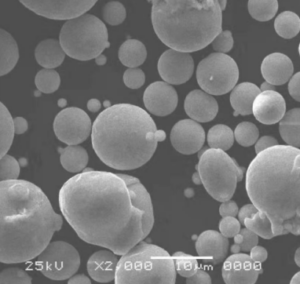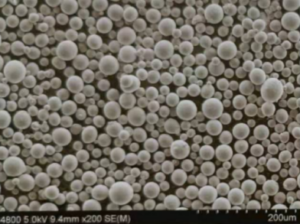Elektroden-Induktionsschmelzen Inertgaszerstäubung (EIGA) ist ein faszinierendes und hochtechnisches Verfahren zur Herstellung von hochwertigen Metallpulvern. Dieses Verfahren wird besonders wegen seiner Fähigkeit geschätzt, Pulver mit hervorragender Reinheit, gleichmäßiger Partikelgrößenverteilung und spezifischer Partikelmorphologie herzustellen, die für verschiedene fortschrittliche Fertigungsanwendungen unerlässlich sind. In diesem ausführlichen Leitfaden gehen wir auf die Feinheiten von EIGA ein, untersuchen spezifische Metallpulvermodelle und geben detaillierte Einblicke in ihre Eigenschaften, Anwendungen und Vorteile.
Überblick über das Elektroden-Induktionsschmelzen Schutzgaszerstäubung
Beim Elektroden-Induktionsschmelzen mit Inertgaszerstäubung wird eine Metallelektrode durch Induktionserwärmung geschmolzen und das geschmolzene Metall anschließend mit Hilfe eines Inertgases in feine Partikel zerstäubt. Dieses Verfahren wird für die Herstellung von Pulvern ohne Verunreinigungen geschätzt, was bei Anwendungen wie der additiven Fertigung, der Pulvermetallurgie und der Hochleistungskeramik entscheidend ist.
Hauptmerkmale des EIGA:
- Reinheit: Das Verfahren minimiert die Verunreinigung und gewährleistet hochreine Metallpulver.
- Kontrolle der Partikelgröße: Ermöglicht eine präzise Kontrolle der Partikelgrößenverteilung.
- Sphärische Partikel: Erzeugt kugelförmige Partikel, die die Fließfähigkeit und Packungsdichte verbessern.
- Vielseitigkeit: Kann für eine breite Palette von Metallen und Legierungen verwendet werden.
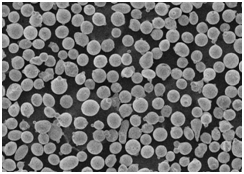
Zusammensetzung und Eigenschaften von EIGA-Pulvern
Das Verständnis der Zusammensetzung und der Eigenschaften von EIGA-Pulvern ist entscheidend für die Auswahl des richtigen Materials für bestimmte Anwendungen. Im Folgenden werden die Zusammensetzung und die Eigenschaften verschiedener mit EIGA hergestellter Metallpulver untersucht.
Arten und Zusammensetzungen von EIGA-Pulvern:
| Metall-Pulver | Zusammensetzung | Eigenschaften |
|---|---|---|
| Titan (Ti-6Al-4V) | 90% Titan, 6% Aluminium, 4% Vanadium | Hohe Festigkeit, leicht, korrosionsbeständig |
| Nickellegierung (Inconel 718) | 50-55% Nickel, 17-21% Chrom, 4,75-5,5% Niob, sowie Eisen, Molybdän, Titan | Hohe Temperaturbeständigkeit, korrosionsbeständig |
| Rostfreier Stahl (316L) | 16-18% Chrom, 10-14% Nickel, 2-3% Molybdän, Rest Eisen | Korrosionsbeständig, gute mechanische Eigenschaften |
| Kobalt-Chrom-Legierung (CoCrMo) | 60-65% Kobalt, 26-30% Chrom, 5-7% Molybdän | Hohe Verschleißfestigkeit, biokompatibel |
| Aluminiumlegierung (AlSi10Mg) | 85-90% Aluminium, 9-11% Silizium, 0,2-0,4% Magnesium | Leichtes Gewicht, gute mechanische Eigenschaften, gießbar |
| Kupfer (Cu) | >99% Kupfer | Ausgezeichnete elektrische und thermische Leitfähigkeit |
| Tungsten (W) | >99% Wolfram | Sehr hohe Dichte, hoher Schmelzpunkt |
| Magnesium-Legierung (AZ91D) | 90-93% Magnesium, 8-9% Aluminium, 0,2-1% Zink | Leichtes Gewicht, gute Gießbarkeit |
| Werkzeugstahl (H13) | 0,32-0,45% Kohlenstoff, 4,75-5,5% Chrom, 1,1-1,75% Molybdän, Rest Eisen | Hohe Verschleißfestigkeit, gute Zähigkeit |
| Titanaluminid (TiAl) | 45-48% Titan, 48-51% Aluminium | Leichtes Gewicht, hohe Temperaturbeständigkeit |
Merkmale der EIGA-Pulver:
| Charakteristisch | Beschreibung |
|---|---|
| Morphologie der Partikel | Sphärisch, verbessert die Fließfähigkeit und Packungsdichte |
| Reinheit | Hoch, da die Inertgasatmosphäre Oxidation und Kontamination verhindert |
| Partikelgrößenverteilung | Schmal und kontrollierbar, entscheidend für präzise Fertigungsprozesse |
| Dichte | Hohe Abstich- und Schüttdichten, vorteilhaft für Pulverbettschmelzverfahren |
| Fläche | Kontrolliert zur Optimierung von Sinter- und Schmelzprozessen |
Anwendungen von EIGA-Pulvern
EIGA-Pulver finden in verschiedenen Branchen Anwendung, die jeweils die einzigartigen Eigenschaften dieser hochwertigen Metallpulver nutzen. Nachfolgend finden Sie eine detaillierte Tabelle, die verschiedene Anwendungen aufzeigt.
Anwendungen und Verwendungen von EIGA-Pulvern:
| Industrie | Anmeldung | Vorteile |
|---|---|---|
| Luft- und Raumfahrt | Turbinenschaufeln, Strukturkomponenten | Hohe Festigkeit im Verhältnis zum Gewicht, Temperaturbeständigkeit |
| Medizinische | Implantate, Prothetik, zahnmedizinische Anwendungen | Biokompatibilität, Korrosionsbeständigkeit |
| Automobilindustrie | Motorkomponenten, Wärmetauscher | Leichtes Gewicht, hohe Leistung |
| Elektronik | Leitfähige Tinten, Wärmesenken | Ausgezeichnete elektrische Leitfähigkeit |
| Energie | Brennstoffzellen, Batteriekomponenten | Hohe Effizienz, Zuverlässigkeit |
| Additive Fertigung | 3D-Druck von komplexen Geometrien | Flexibilität im Design, weniger Materialabfall |
| Pulvermetallurgie | Gesinterte Teile, Lager | Hohe Dichte, einheitliches Gefüge |
| Beschichtungen | Thermische Spritzschichten, Verschleißschutzschichten | Verbesserte Oberflächeneigenschaften, Haltbarkeit |
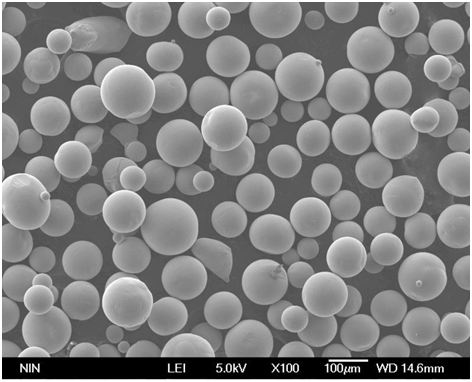
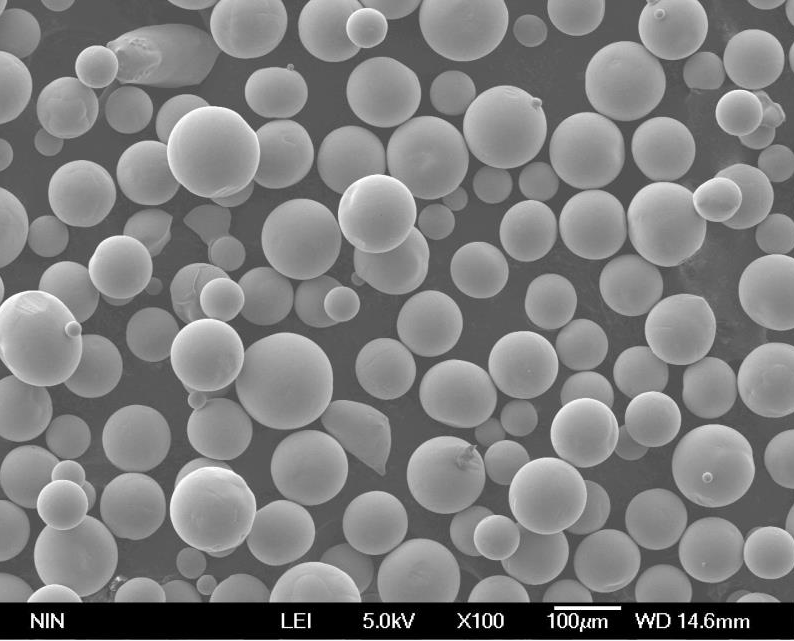
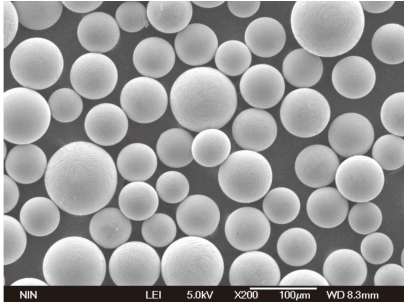
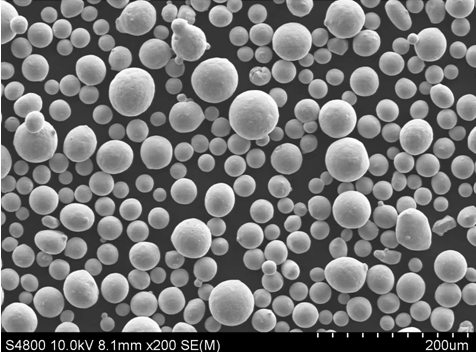
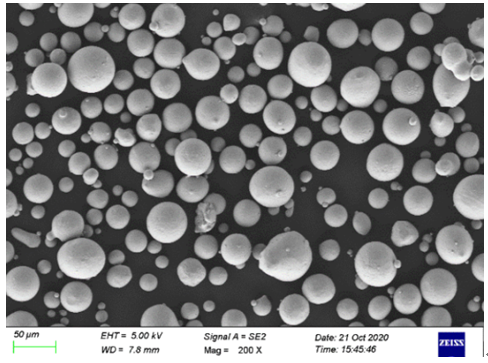
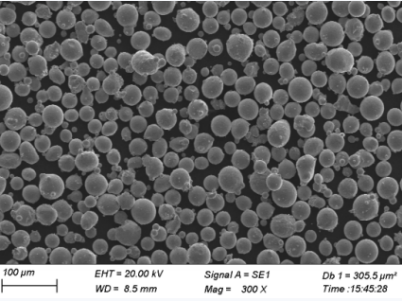
Spezifikationen, Größen, Güteklassen und Normen
Bei der Auswahl von EIGA-Pulvern für bestimmte Anwendungen ist es wichtig, die Spezifikationen, Größen, Qualitäten und Normen für diese Materialien zu kennen.
Spezifikationen und Normen für EIGA-Pulver:
| Metall-Pulver | Partikelgrößenbereich (µm) | Standard-Grade | Einschlägige Normen |
|---|---|---|---|
| ti-6al-4v | 15-45, 45-90 | Klasse 5 | ASTM F2924 |
| Inconel 718 | 15-45, 45-106 | AMS 5662 | AMS 5662, ASTM B637 |
| 316L-Edelstahl | 15-45, 45-106 | ASTM F138 | ASTM A276, F138 |
| CoCrMo | 15-45, 45-106 | ASTM F75 | ASTM F75 |
| AlSi10Mg | 15-45, 45-106 | DE AC-43400 | EN 1706 |
| Kupfer | 15-45, 45-106 | OFHC | ASTM B216 |
| Tungsten | 15-45, 45-106 | W1, W2 | ASTM B777 |
| AZ91D Magnesium | 15-45, 45-106 | ASTM B93/B93M | ASTM B93/B93M |
| H13 Werkzeugstahl | 15-45, 45-106 | ASTM A681 | ASTM A681 |
| Titanaluminid | 15-45, 45-106 | Benutzerdefiniert | ISO 5832-3 |
Lieferanten und Preisangaben
Für die Beschaffung hochwertiger EIGA-Pulver ist es wichtig, seriöse Lieferanten zu identifizieren und die Preisgestaltung zu kennen. Nachstehend finden Sie eine Tabelle mit einigen wichtigen Lieferanten und Richtpreisen.
Lieferanten und Preisgestaltung von EIGA-Pulver:
| Anbieter | Metall-Pulver | Preisspanne (USD/kg) | Kontaktinformationen |
|---|---|---|---|
| Praxair Oberflächentechnologien | ti-6al-4v | $200 – $300 | Praxair Website |
| Zimmerer-Zusatzstoff | Inconel 718 | $150 – $250 | Carpenter Additive Website |
| GKN Hoeganaes | 316L-Edelstahl | $100 – $200 | GKN Hoeganaes Website |
| HC Starck Lösungen | CoCrMo | $200 – $300 | HC Starck Solutions Website |
| ECKART Amerika | AlSi10Mg | $50 – $100 | ECKART Website |
| AMETEK Spezialmetallprodukte | Kupfer | $50 – $100 | AMETEK SMP Website |
| Advanced Powder & Coatings Ltd. | Tungsten | $300 – $500 | Website von Advanced Powder & Coatings |
| Zhongnuo Fortgeschrittenes Material | AZ91D Magnesium | $50 – $100 | Zhongnuo Website |
| Kennametal | H13 Werkzeugstahl | $100 – $200 | Kennametal Website |
| ATI-Metalle | Titanaluminid | $300 – $500 | ATI Metals Website |
Vergleich der Vor- und Nachteile von EIGA-Pulvern
Die Bewertung der Vorteile und Grenzen von EIGA-Pulvern hilft dabei, fundierte Entscheidungen für bestimmte Anwendungen zu treffen.
Vorteile und Grenzen der EIGA-Pulver:
| Vorteil | Beschreibung |
|---|---|
| Hohe Reinheit | EIGA minimiert die Kontamination und produziert hochreine Pulver. |
| Gleichmäßige Partikelgröße | Ermöglicht eine präzise Kontrolle der Partikelgrößenverteilung. |
| Sphärische Partikel | Verbessert die Fließfähigkeit und Packungsdichte, die für die additive Fertigung entscheidend sind. |
| Vielseitiges Materialangebot | Kann Pulver aus einer breiten Palette von Metallen und Legierungen herstellen. |
| Niedriger Sauerstoffgehalt | Die Inertgasatmosphäre reduziert die Oxidation und erhält die Materialintegrität. |
| Begrenzung | Beschreibung |
|---|---|
| Kosten | EIGA-Pulver können im Vergleich zu anderen Methoden teurer sein. |
| Komplexität | Das Verfahren erfordert hochentwickelte Geräte und Fachwissen. |
| Produktion Volumen | Die Menge des Pulvers, die in einer einzigen Charge hergestellt werden kann, kann begrenzt sein. |
| Energieverbrauch | Hoher Energiebedarf aufgrund des Induktionsschmelzens. |
Detaillierte Einblicke und Beispiele
Titan (Ti-6Al-4V) vs. Inconel 718:
Titan Ti-6Al-4V und Inconel 718 sind zwei bekannte Metallpulver, die in Hochleistungsanwendungen eingesetzt werden. Ti-6Al-4V ist für sein hohes Festigkeits-Gewichts-Verhältnis und seine Korrosionsbeständigkeit bekannt und wird häufig in der Luft- und Raumfahrt sowie in der Biomedizin eingesetzt. Im Gegensatz dazu wird Inconel 718 mit seiner überragenden Hochtemperaturfestigkeit und Oxidationsbeständigkeit bevorzugt für Bauteile in der Luft- und Raumfahrt verwendet, die unter extremen Bedingungen arbeiten. Beim Vergleich der beiden Werkstoffe ist Ti-6Al-4V leichter und eignet sich besser für gewichtssensible Anwendungen, während Inconel 718 eine bessere Leistung unter Hochtemperaturbedingungen bietet.
Edelstahl 316L vs. Aluminiumlegierung (AlSi10Mg):
Edelstahl 316L und die Aluminiumlegierung AlSi10Mg werden in der additiven Fertigung häufig verwendet. 316L wird wegen seiner Korrosionsbeständigkeit und seiner mechanischen Eigenschaften bevorzugt und ist daher ideal für medizinische und maritime Anwendungen. AlSi10Mg hingegen ist leicht und gießbar und eignet sich hervorragend für Anwendungen in der Automobil- und Luftfahrtindustrie, bei denen eine Gewichtsreduzierung von entscheidender Bedeutung ist. Die Wahl zwischen diesen beiden Werkstoffen hängt oft von den spezifischen Anforderungen der Anwendung ab, wobei 316L eine lange Lebensdauer und AlSi10Mg eine Gewichtseinsparung bietet.
Kobalt-Chrom-Legierung (CoCrMo) für medizinische Anwendungen:
Die Kobalt-Chrom-Legierung (CoCrMo) wird aufgrund ihrer hohen Verschleißfestigkeit und Biokompatibilität häufig in der Medizintechnik eingesetzt, insbesondere bei Implantaten und Prothesen. Die Fähigkeit der Legierung, der rauen Umgebung des Körpers standzuhalten, ohne sich zu zersetzen, macht sie zu einer ersten Wahl für Langzeitimplantate. Darüber hinaus eignen sich ihre mechanischen Eigenschaften gut für tragende Anwendungen und gewährleisten Zuverlässigkeit und Langlebigkeit in medizinischen Geräten.
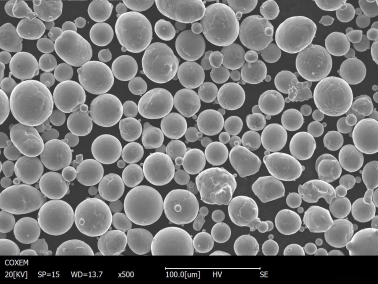
FAQ
| Frage | Antwort |
|---|---|
| Was ist Elektrodeninduktionsschmelzen - Schutzgaszerstäubung? | EIGA ist ein Verfahren, bei dem eine Metallelektrode durch Induktionserwärmung geschmolzen und das geschmolzene Metall mit Hilfe eines Inertgases in feine Partikel zerstäubt wird. |
| Welche Metalle können mit EIGA verarbeitet werden? | Eine breite Palette von Metallen und Legierungen, darunter Titan, Nickel, Edelstahl, Kobalt-Chrom, Aluminium, Kupfer, Wolfram, Magnesium, Werkzeugstahl und Titanaluminid. |
| Was sind die Vorteile der Verwendung von EIGA-Pulvern? | EIGA-Pulver bieten einen hohen Reinheitsgrad, eine einheitliche Partikelgröße, eine kugelförmige Morphologie und einen geringen Sauerstoffgehalt, wodurch sie sich ideal für moderne Fertigungsanwendungen eignen. |
| Wie schneidet EIGA im Vergleich zu anderen Pulverherstellungsmethoden ab? | Die EIGA bietet im Vergleich zu Methoden wie der Gas- oder Wasserzerstäubung eine bessere Reinheit und Partikelkontrolle, obwohl sie teurer und komplexer sein kann. |
| Was sind gängige Anwendungen von EIGA-Pulvern? | Zu den Anwendungsbereichen gehören Komponenten für die Luft- und Raumfahrt, medizinische Implantate, Automobilteile, Elektronik, Energiesysteme, additive Fertigung, Pulvermetallurgie und Beschichtungen. |
| Welche Faktoren sollten bei der Auswahl von EIGA-Pulvern berücksichtigt werden? | Zu den wichtigsten Faktoren gehören die spezifischen Anwendungsanforderungen, die gewünschten Materialeigenschaften, die Partikelgrößenverteilung, die Reinheit und die Kosten. |
| Können EIGA-Pulver in der additiven Fertigung verwendet werden? | Ja, EIGA-Pulver eignen sich aufgrund ihrer kontrollierten Partikelgrößenverteilung und hohen Reinheit hervorragend für die additive Fertigung, was die Qualität der gedruckten Teile verbessert. |
| Was ist der typische Partikelgrößenbereich für EIGA-Pulver? | Die Partikelgrößen liegen in der Regel zwischen 15 und 106 Mikron, je nach Anwendung und Anforderungen. |
| Gibt es irgendwelche Einschränkungen bei der Verwendung von EIGA-Pulvern? | Zu den Einschränkungen gehören höhere Kosten, die Komplexität des Verfahrens, begrenzte Produktionsmengen und ein hoher Energieverbrauch. |
| Wo kann ich EIGA-Pulver kaufen? | Zu den namhaften Anbietern gehören Praxair Surface Technologies, Carpenter Additive, GKN Hoeganaes, HC Starck Solutions, ECKART America, AMETEK Specialty Metal Products, Advanced Powder & Coatings Ltd, Zhongnuo Advanced Material, Kennametal, und ATI Metals. |
Schlussfolgerung
Elektroden-Induktionsschmelzen Inertgaszerstäubung ist eine Spitzentechnologie, die bei der Herstellung von hochwertigen Metallpulvern eine zentrale Rolle spielt. Ihre Fähigkeit, Pulver mit außergewöhnlicher Reinheit, präziser Partikelgrößenverteilung und kugelförmiger Morphologie herzustellen, macht sie in fortschrittlichen Fertigungsbereichen wie der Luft- und Raumfahrt, der Medizintechnik und der additiven Fertigung unverzichtbar. Wenn man die Zusammensetzung, die Eigenschaften, die Anwendungen und die Vorteile von EIGA-Pulvern versteht, kann die Industrie diese Technologie nutzen, um überlegene Leistungen und Innovationen in ihren Produkten zu erzielen.
Egal, ob Sie Ingenieur, Forscher oder Hersteller sind, dieser umfassende Leitfaden bietet Ihnen das Wissen und die Erkenntnisse, die Sie benötigen, um sich in der Komplexität der EIGA-Pulver zurechtzufinden und fundierte Entscheidungen für Ihre spezifischen Anforderungen zu treffen.
